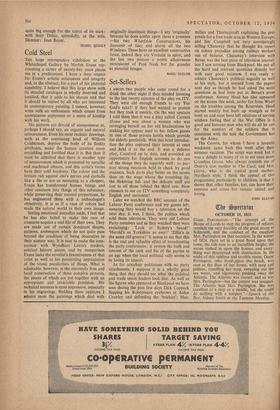Cold Steel
THE large retrospective exhibition at the Whitechapel Gallery by Merlyn Evans rep- resenting a career of twenty-five years places me in a predicament. I have a deep respect for Evans's artistic seriousness and integrity and, in the abstract, for a part of his pictorial capability. I believe that this large show with its detailed catalogue is wholly deserved and justified, that it adds to his stature and that it should be visited by all who are interested in contemporary painting. I cannot, however, write with an enthusiasm which comes from spontaneous enjoyment or a sense of kinship with his work.
His pictures arc devoid of sensuousness or, perhaps I should say, an organic and natural sensuousness. Even his most realistic drawings, such as the convincing head of William Coldstream, deprive the body of its fleshly attributes, make the human creature more unyielding and fortified than it is. But then it must be admitted that there is another type of sensuousness which is presented by metallic and machined objects, and this artist's forms have their cold hardness. The colour and the texture rub against one's nerves and eyeballs like a file or are as menacing as a chopper. Evans has transformed human beings and other creatures into things of this substance; while preserving their natural proportions, he has engineered them with a technologist's objectivity. It is as if a race of robots had made the natural world in their own image.
Setting emotional prejudice aside, I feel that he has also failed to make this race of creatures acquire a real life of their own. They are made out of certain dominant shapes, patterns, arabesques which do not quite pass beyond the condition of being decorative in their austere way. It is easy to make the com- parison with Wyndham Lewis's modern, satirical history pieces, and by comparison Evans lacks the novelist's inventiveness of that artist as well as his penetrating appreciation of the visual pecularities of things. What is admirable, however, is the extremely firm and lucid construction of these complex pictures, the pieces of which are put together with an appropriate and invariable precision. His technical sureness is most impressive, especially in his engravings. Holding these opinions I admire most the paintings which deal with originally inanimate things—I say 'originally' because he does confer upon them a presence —his two Wharfside Constructions, his Souvenir of Suez and above all the two Windows. These have an excellent constructive force, indeed they are Vorticist in spirit, and the last two possess a poetic allusiveness reminiscent of Paul Nash but far grander as pictorial images.
BASIL TAYLOR










































 Previous page
Previous page